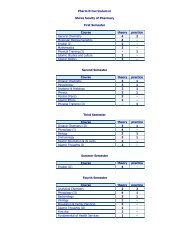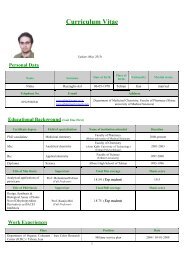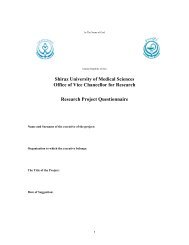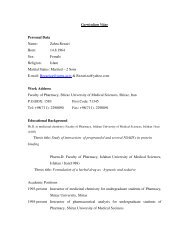Technetium radiopharmaceuticals
Technetium radiopharmaceuticals
Technetium radiopharmaceuticals
You also want an ePaper? Increase the reach of your titles
YUMPU automatically turns print PDFs into web optimized ePapers that Google loves.
<strong>Technetium</strong> <strong>radiopharmaceuticals</strong><br />
• The chemical form of 99m Tc available from the Moly generator is<br />
sodium pertechnetate ( 99m Tc-NaTcO 4 ). The pertechnetate ion, 99m TcO 4 ,<br />
having the oxidation state +7 for 99m Tc.<br />
• Chemically, 99m TcO 4 is a rather non reactive species and does not label<br />
4<br />
any compound by direct addition. In 99mTc-labeling of many<br />
compounds, prior reduction of 99mTc from the 7 state to a lower<br />
oxidation state is required.<br />
• In 99m Tc-labeling of many compounds, prior reduction of 99m Tc from the<br />
+7 state to a lower oxidation state is required.
• Various reducing agents that have been used are stannous chloride<br />
(SnCl 2 H 2O 2 2), stannous citrate, stannous tartrate, concentrated HCl,<br />
sodium borohydride (NaBH 4 ), dithionite, and ferrous sulfate.<br />
• stannous chloride is the most commonly used reducing agent in<br />
most preparations of 99mTc-labeled compounds
What Are Cold Kits?<br />
o Non-radioactive components required to produce the<br />
radiopharmaceutical after addition of the radionuclide.<br />
o<br />
o<br />
Change the chemical and biodistribution is also altered.<br />
The kits have a long shelf life and can be purchased and stored well<br />
ahead of daily preparation<br />
o 99m Tc-labeling can be accomplished simply by adding 99m TcO 4 to<br />
most kits
Cold Kit Components<br />
• Chelating/Complexing agent<br />
• Reducing agent – usually stannous chloride<br />
• Inert atmosphere (vacuum, nitrogen)<br />
◦ Why?<br />
• Stabiliser if required (ascorbic acid for MDP)<br />
• Usually in a lyophilised state (freeze dried) for stability
• The chelating agent usually donates lone pairs of electrons to form<br />
coordinate covalent bonds with reduced d 99mTc. Chemical groups<br />
such as —COO,—OH,—NH2, and—SH are the electron donors in<br />
compounds such as DTPA, gluceptate, and various proteins
• in a preparation of a 99m Tc-labeled compound, three 99m Tc species<br />
may be present:<br />
1. ‘‘Free’’ 99m Tc as 99m TcO 4 that has not been reduced by Sn 2+ .<br />
2. ‘‘Hydrolyzed’’ 99m Tc, such as 99m TcO 2 that did not react with the<br />
chelating agent; this includes reduced 99mTc bound to hydrolyzed<br />
Sn 2+ (Sn(OH) 2 ).<br />
3. ‘‘Bound’’ 99mTc-chelate, which is the desired compound formed by<br />
binding of reduced 99m Tc to the chelating agent
<strong>Technetium</strong> <strong>radiopharmaceuticals</strong>
Clinical uses
preparation
Clinical uses
Preparation
uses
Preparation
Clinical uses
Tc-99m Labeled WBCs<br />
•Used for localizing infection and<br />
abscesses<br />
•Principle of labeling<br />
◦Tc-99m HMPAO is lipophilic and crosses lipid<br />
bilayer of cell membranes<br />
◦Inside the cell the HMPAO complex is broken<br />
down and the resulting charged Tc-99m<br />
species is trapped in the cell<br />
◦All cells present are labeled so prior leukocyte<br />
separation is necessary
Tc-99m WBC Labeling Procedure<br />
• Obtain 30-50 mL whole blood<br />
from patient t with anticoagulant<br />
t<br />
• add Hetastarch as a<br />
sedimentation aid<br />
• Hang syringe in an inverted<br />
position<br />
• Allow 30-60 min for RBC to<br />
sediment
Tc-99m WBC Labeling Procedure<br />
• Centrifuge. Remove platelet-rich<br />
supernatant.<br />
t<br />
• Centrifuge. Use platelet-poor<br />
plasma (PPP) to resuspend WBC<br />
• Add 30 mCi freshly yprepared p Tc-<br />
99m HMPAO: labeling 10 - 80 %.<br />
Do NOT use Methylene Blue.<br />
• Centrifuge. Remove supernatant.
Tc-99m WBC Labeling Procedure<br />
• Resuspend labeled WBC in platelet<br />
poor plasma<br />
• Draw up dose for patient<br />
• Inject patient. If patient has been on<br />
dialysis, wait until procedure is<br />
complete
Three Ways to Prepare Tc-99m<br />
RBCs<br />
•In vivo labeling<br />
•Modified in vivo labeling<br />
•In vitro labeling li (UltraTag)
In-Vitro Method<br />
•Blood is drawn from patient and RBC’s are<br />
separated by centrifugation and washing<br />
•The cells are then incubated with<br />
appropriate amount of Sn and then<br />
washed to remove excess tin<br />
•The appropriate amount of pertechnetate<br />
is then added and allowed to incubate<br />
•Labeling efficiency is >97%
In-Vivo Method<br />
•A kit of Sn-PYP is reconstituted with<br />
isotonic saline<br />
•The proper dose (10-20 microgram/kg) is<br />
injected into patient<br />
•Wait 20 to 30 minutes and inject 20-30<br />
mCi of pertechnetate to tag the RBC’s<br />
immediately<br />
•Labeling efficiency is 80-90%
Modified In-Vivo Method<br />
•20-30 mCi pertechnetate<br />
•Heparinized saline<br />
•20 minutes post injection of Sn-PYP draw<br />
3 ml of blood into Tc99m syringe and<br />
incubate 10 minutes (shake gently)<br />
•Inject labeled cells back into patient and<br />
flush with saline<br />
•Labeling yield >95%
Radioiodine( 131 I, 123 I, 125 I)<br />
•Radionuclide R properties<br />
◦Mod of decay<br />
◦Energy<br />
•Radionuclide production<br />
• 124 Xe (n,γ)→ 125m Xe(57s)→ 125 I (60 d) → 125 Te<br />
• 124 Xe (p,2n)→ 123 Cs(5.9 min)→ 123 I (13 d)→ 123 Te<br />
• 235 U (n,f) → 131 Te (30h)→ 131 I (8 d) → 130 Xe<br />
• 130 Te (n,γ)→ 131 Te (30h)→ 131 I (8 d) → 130 Xe
Iodine chemistry<br />
•Chemical i l properties<br />
•Labeling g with radioiodine<br />
◦Electrophyllic substitution<br />
◦Nucleophillic substitution<br />
◦Isotope exchange
Protein labeling<br />
• Monochloride iodine<br />
• Chloramine T<br />
•Solid phase<br />
• Iodogen<br />
• Iodobeads<br />
• Bultone hunter
Iodine radiopharmaceutical<br />
•Radioiodides<br />
•Iobenguan(MIBG)<br />
• 125 I-Albumin<br />
• 123 I- or 131 I-Sodium Orthoiodohippurate
• 125 I-Sodium Iothalamate
Gallium<br />
•Gallium radionuclides<br />
•Radionuclide production<br />
• 68 Zn (p,2n)→ 67 Ga(3.26 d)→ 67 Zn<br />
•Gallium citrate
Indium<br />
•ProductionP d • 111 Cd (p,n)→ 111 In(2.8 d)→ 111 Cd<br />
•Radiopharmaceutical<br />
◦Indium chloride<br />
◦Indium oxime<br />
◦In DTPA<br />
◦In-Ab<br />
◦In- penteriotide<br />
◦In-WBC
In- WBC
Other radionuclides<br />
• Thallium 201<br />
• Xenon 133<br />
• Chromium 51<br />
• Cobalt 57<br />
• Phosphorus 32<br />
• Strontium 89<br />
• Yttrium 90<br />
• Samarium153









